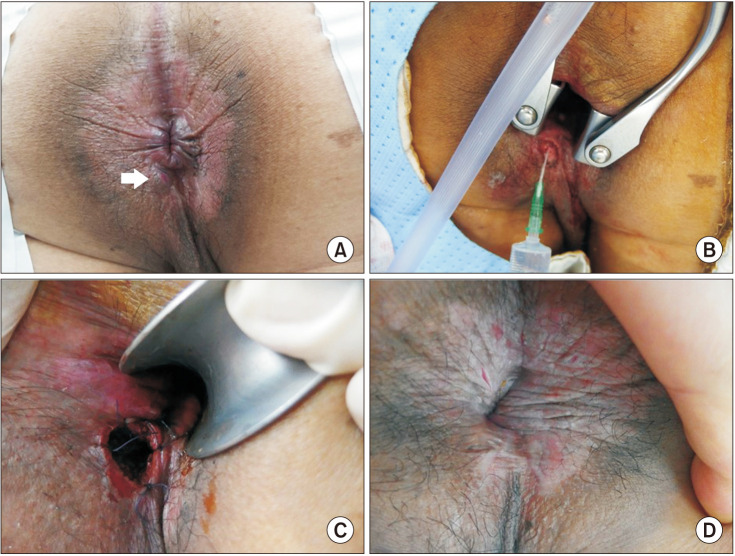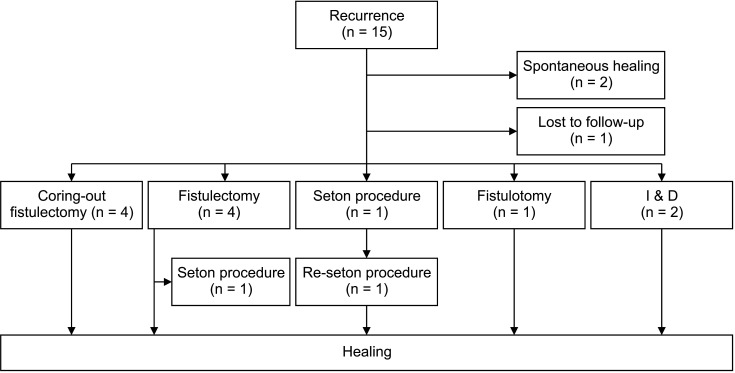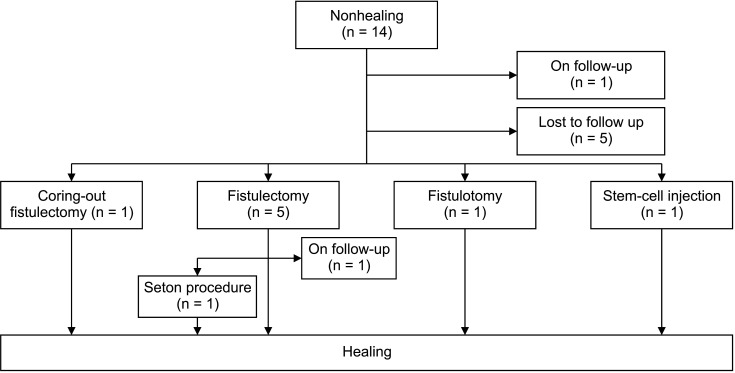Ann Surg Treat Res.
2022 Mar;102(3):167-175. 10.4174/astr.2022.102.3.167.
Coring-out fistulectomy for perianal cryptoglandular fistula: a retrospective cohort study on 20 years of experience at a single center
- Affiliations
-
- 1Department of Surgery, The Catholic University of Korea, Uijeongbu St. Mary’s Hospital, Uijeongbu, Korea
- 2Department of Surgery, Seoul National University Hospital, Seoul National University College of Medicine, Seoul, Korea
- 3Department of Surgery, Dongnam Institute of Radiological and Medical Sciences, Busan, Korea
- 4Department of Surgery, Uijeongbu Eulji Medical Center, Eulji University, Uijeongbu, Korea
- KMID: 2526938
- DOI: http://doi.org/10.4174/astr.2022.102.3.167
Abstract
- Purpose
Cryptoglandular fistula is one of the common anal diseases requiring surgical treatment. Various surgical techniques have been introduced; however, there is no known standard technique. Coring-out fistulectomy is a surgical technique that accurately resects only the fistula tract. However, only a few cases of this procedure have been reported. We aimed to analyze the surgical outcomes of coring-out fistulectomy for cryptoglandular anal fistulas.
Methods
We retrospectively reviewed the medical records of patients who underwent coring-out fistulectomy for a cryptoglandular fistula between 1999 and 2019. Primary outcomes were the treatment success rate (recurrence and healing rates) and incidence of fecal incontinence.
Results
A total of 184 patients were included in our study. The average age of the patients was 44 years (range, 16–75 years), and 88.0% were male. Twenty-four (13.0%), 13 (7.1%), and 68 patients (37.0%) underwent operation for recurrent fistula, multiple tracts, and complex type fistula, respectively. The healing rate was 92.4%, and recurrence occurred in 15 of 170 healed patients (8.8%). Thus, the treatment success rate was 84.2%. There was no fecal incontinence except in 1 patient who had preoperative fecal incontinence because of cauda equine syndrome. In multivariable analysis of the factors affecting the treatment success rate, the complex fistula (odds ratio [OR], 14.2; 95% confidence interval [CI], 4.7– 43.0; P < 0.001) and undetected internal opening during the operation (OR, 4.0; 95% CI, 1.4–11.6; P = 0.012) were significant factors.
Conclusion
Coring-out fistulectomy is a simple and feasible technique for sphincter-preserving anal fistula surgery.
Keyword
Figure
Reference
-
1. Zanotti C, Martinez-Puente C, Pascual I, Pascual M, Herreros D, García-Olmo D. An assessment of the incidence of fistula-in-ano in four countries of the European Union. Int J Colorectal Dis. 2007; 22:1459–1462. PMID: 17554546.
Article2. Wolff BC, Beck DE, Church JM, Fleshman JW, Garcia-Aguilar J, Pemberton JH. The ASCRS textbook of colon and rectal surgery. New York: Springer;2007.3. Eisenhammer S. The internal anal sphincter and the anorectal abscess. Surg Gynecol Obstet. 1956; 103:501–506. PMID: 13360660.4. Ratto C, Grossi U, Litta F, Di Tanna GL, Parello A, De Simone V, et al. Contemporary surgical practice in the management of anal fistula: results from an international survey. Tech Coloproctol. 2019; 23:729–741. PMID: 31368010.
Article5. Garcia-Aguilar J, Belmonte C, Wong WD, Goldberg SM, Madoff RD. Anal fistula surgery: factors associated with recurrence and incontinence. Dis Colon Rectum. 1996; 39:723–729. PMID: 8674361.6. Rojanasakul A. LIFT procedure: a simplified technique for fistula-in-ano. Tech Coloproctol. 2009; 13:237–240. PMID: 19636496.
Article7. Emile SH, Khan SM, Adejumo A, Koroye O. Ligation of intersphincteric fistula tract (LIFT) in treatment of anal fistula: an updated systematic review, meta-analysis, and meta-regression of the predictors of failure. Surgery. 2020; 167:484–492. PMID: 31648932.
Article8. Meinero P, Mori L. Video-assisted anal fistula treatment (VAAFT): a novel sphincter-saving procedure for treating complex anal fistulas. Tech Coloproctol. 2011; 15:417–422. PMID: 22002535.
Article9. Emile SH, Elfeki H, Shalaby M, Sakr A. A systematic review and meta-analysis of the efficacy and safety of video-assisted anal fistula treatment (VAAFT). Surg Endosc. 2018; 32:2084–2093. PMID: 29052068.
Article10. Lewis A. Excision of fistula in ano. Int J Colorectal Dis. 1986; 1:265–267. PMID: 3598323.
Article11. Gustafsson UM, Graf W. Excision of anal fistula with closure of the internal opening: functional and manometric results. Dis Colon Rectum. 2002; 45:1672–1678. PMID: 12473893.12. Jivapaisarnpong P. Core out fistulectomy, anal sphincter reconstruction and primary repair of internal opening in the treatment of complex anal fistula. J Med Assoc Thai. 2009; 92:638–642. PMID: 19459524.13. Miller GV, Finan PJ. Flap advancement and core fistulectomy for complex rectal fistula. Br J Surg. 1998; 85:108–110. PMID: 9462397.
Article14. Agha R, Abdall-Razak A, Crossley E, Dowlut N, Iosifidis C, Mathew G, et al. STROCSS 2019 Guideline: strengthening the reporting of cohort studies in surgery. Int J Surg. 2019; 72:156–165. PMID: 31704426.
Article15. Parks AG, Gordon PH, Hardcastle JD. A classification of fistula-in-ano. Br J Surg. 1976; 63:1–12. PMID: 1267867.
Article16. Steele SR, Kumar R, Feingold DL, Rafferty JL, Buie WD. Standards Practice Task Force of the American Society of Colon and Rectal Surgeons. Practice parameters for the management of perianal abscess and fistula-in-ano. Dis Colon Rectum. 2011; 54:1465–1474. PMID: 22067173.
Article17. Tobisch A, Stelzner S, Hellmich G, Jackisch T, Witzigmann H. Total fistulectomy with simple closure of the internal opening in the management of complex cryptoglandular fistulas: long-term results and functional outcome. Dis Colon Rectum. 2012; 55:750–755. PMID: 22706126.
Article18. Weledji EP. Idiopathic anal fistula: fistulotomy or fistulectomy? Adv Res Gastroentero Hepatol. 2018; 11:555817.
Article19. Tozer P, Phillips RK. Anal fistula: evaluation and management. Clark S, editor. Colorectal surgery. 6th ed. Philadelphia: Elsevier;2019. p. 206–222.20. Göttgens KW, Janssen PT, Heemskerk J, van Dielen FM, Konsten JL, Lettinga T, et al. Long-term outcome of low perianal fistulas treated by fistulotomy: a multicenter study. Int J Colorectal Dis. 2015; 30:213–219. PMID: 25421101.
Article21. Visscher AP, Schuur D, Roos R, Van der Mijnsbrugge GJ, Meijerink WJ, Felt-Bersma RJ. Long-term follow-up after surgery for simple and complex cryptoglandular fistulas: fecal incontinence and impact on quality of life. Dis Colon Rectum. 2015; 58:533–539. PMID: 25850841.
Article22. Williams G, Williams A, Tozer P, Phillips R, Ahmad A, Jayne D, et al. The treatment of anal fistula: second ACPGBI Position Statement - 2018. Colorectal Dis. 2018; 20 Suppl 3:5–31.
Article23. Poon CM, Ng DC, Ho-Yin MC, Li RS, Leong HT. Recurrence pattern of fistula-in-ano in a Chinese population. J Gastrointestin Liver Dis. 2008; 17:53–57. PMID: 18392245.24. Sainio P, Husa A. Fistula-in-ano: clinical features and long-term results of surgery in 199 adults. Acta Chir Scand. 1985; 151:169–176. PMID: 4002981.
- Full Text Links
- Actions
-
Cited
- CITED
-
- Close
- Share
- Similar articles
-
- Anal Fistula and Perianal Abscess in Pediatric and Adolescent Patients
- The Effect of Fistulectomy with Seton in Intersphincteric Fistula
- Fistula-in-Ano in Children less than 2 Years of Age
- A Clinical Study of Fistula-in-Ano and Perianal Abscess in Childhood
- Treatment Strategy for Perianal Fistulas in Crohn Disease Patients: The Surgeon’s Point of View




